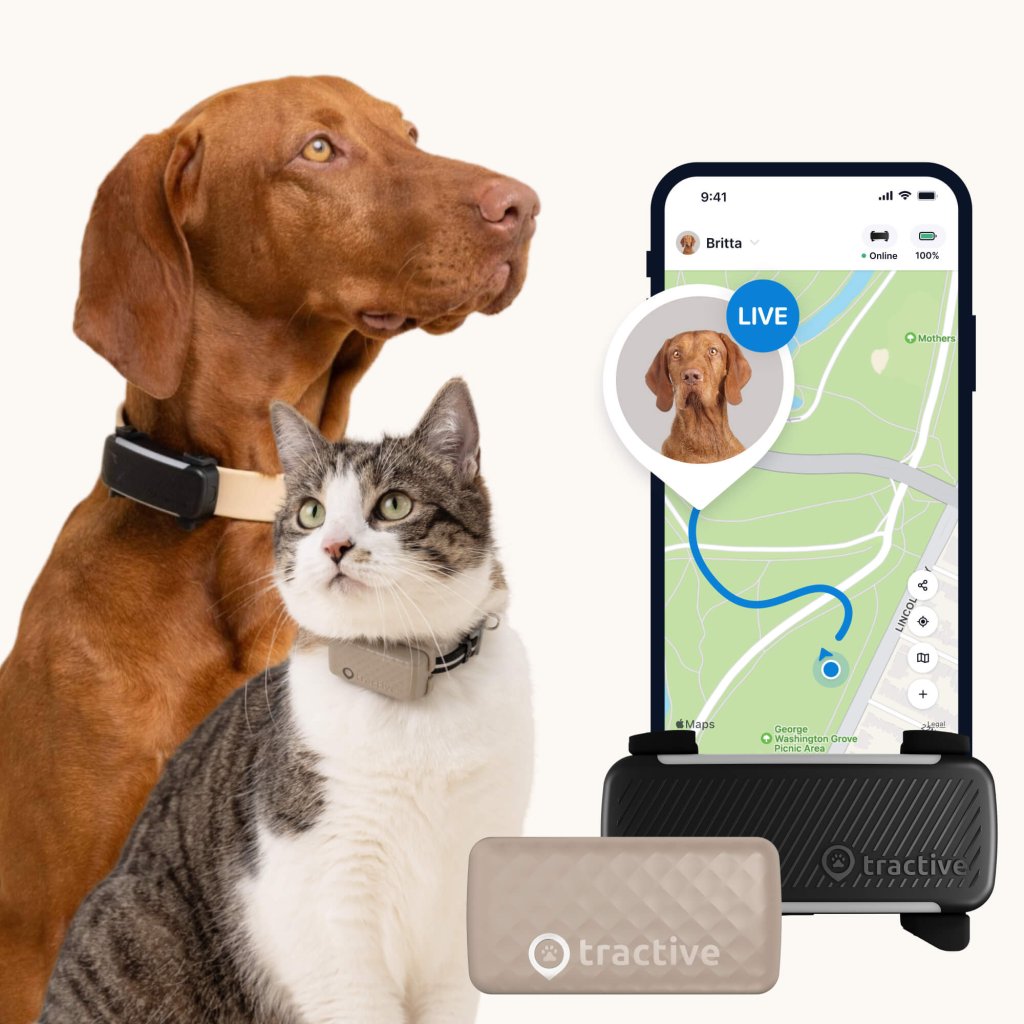Understanding How Pet Insurance Works: A Step-by-Step Breakdown
Pet insurance helps people around the world look after their furry friends and manage veterinary expenses. Discover how it works - and how it can help you - in this post.

The life of a pet parent comes with it’s fair share of surprises. While we hate to think about it, our pets could suffer from unexpected illness or injury. Like an unexpected car repair, vet bills can come out of nowhere. That’s where pet insurance comes in – it can help prepare and protect you against unexpected expenses related to your pet. You’ll learn how pet insurance works in this post. And while you’re here, discover the GPS tracker that could save your pet’s life.

Find out where your cat spends their time.
Read moreHow does pet insurance work?
Pet insurance can help provide peace of mind for pet parents by protecting against unexpected vet bills and expenses.
Pet insurance plans are paid monthly, quarterly, or annually. When you get one, you’ll get a detailed policy telling you exactly what’s covered, what you can expect to get back, your deductible, and the annual maximum that insurance will cover.
Should your pet ever require medical attention, you can take your pet to any licensed vet, and your pet insurance provider will cover expenses in line with your policy.
Usually you need to pay your veterinarian directly for any expenses and submit the receipts to your insurer. So hold on to the paperwork after your vet visit! You might need it when making your claim.
Once you’ve filed your claim, your insurance provider will review it and decide if it’s something they have to cover. Assuming it is, you should usually receive the funds within 14 days.
Some pet insurance providers allow certain vets to bill them directly. That means you don’t have to pay upfront.
What does “deductible”, “reimbursement rate”, and “limit” mean?
To really understand how pet insurance works, it’s important to be familiar with the terminology. Pet insurance policies use some fancy terms – like deductible, reimbursement rate, and limits – to describe certain parts of the contract. Luckily, these aren’t too tricky to figure out! Here are a few of the most important terms and their meanings:
What is a pet insurance deductible?
A deductible is the amount of money that the pet insurance policy holder will be expected to pay before insurance benefits begin.
It’s the initial amount of money you need to pay out of pocket – and won’t be reimbursed for.
There are two types of deductibles: annual deductibles and per-incident deductibles.
- Annual deductible: the amount of money you’re required to pay for all policy-covered incidents each year.
- Per-incident deductible (or per-condition deductible): the amount you have to cover for each incident (injury or illness) your pet has.
When choosing a pet insurance plan, it’s a good idea to choose a deductible that fits your budget. Keep in mind: a lower deductible usually means a higher premium. Some pet insurance companies offer diminishing deductibles for each year you go without making a claim.
What is a reimbursement rate?
Another term you might see in your pet insurance contract is reimbursement rate.
Reimbursement rate is the percentage of veterinary costs that the pet insurance company pays on eligible claims after the deductible has been paid.
Many pet insurance plans offer a reimbursement rate of 80% to 90%. This determines how much money you’ll be reimbursed – after your claim is successfully processed.
To receive reimbursement for a veterinary expense, you have to file a claim with your pet insurance. Once the claim is approved, you will receive a check or direct deposit to your bank account based on the reimbursement rate.
Generally, the higher the reimbursement rate, the higher the premium and/or deductible will be.
What is a limit for pet insurance?
You may also come across the term limit or limits in your pet insurance plan.
The limit (also known as reimbursement limit or payout limit) refers to the maximum amount of money the pet insurance provider will pay after the deductible has been met.
Depending on the plan, you may find these types of limits specified:
- Per incident limit: the maximum amount the insurance company will pay for a single incident.
- Per lifetime limit: the maximum amount the insurance company will pay over the course of your pet’s lifetime.
- Annual limit: the maximum amount the insurance company will pay per year.
- Body systems limit: the maximum amount the insurance company will pay for incidents related to a certain body part.
Annual limit policies are usually more affordable – but you may need to pay out of pocket even with insurance if your pet’s veterinary care expenses exceed the yearly amount.
On the other hand, some companies offer no limit policies, where there’s no limit to how much your provider will pay for vet care that’s covered under your policy. However, these plans are usually more expensive.
Do you need pet insurance?
When deciding if you need pet insurance, it’s wise to consider what you’d do in the case of an unexpected bill. Vet bills can sometimes go into the hundreds or thousands range. Not to mention what you’d have to pay if your pet damages someone else’s property or does someone harm.
Consider what you can afford out of pocket, as well as the following factors:
- Age: Many people insure their pets from the time they’re puppies or kittens. With older pets, insurance might be more expensive, but they usually need more medical care.
- Type of pet: Pet insurance for cats and dogs is widely available, however you can also find insurance policies for other types of pets, such as rabbits and hamsters.
- Self-insurance: You could set aside money yourself for covering unexpected pet expenses, but with this route you’d need a lot of discipline and to make sure that the money is available when it’s needed.
- Risk level: Is your pet of a certain breed that’s more likely to be stolen? Or are they more likely to develop congenital diseases or hereditary conditions? If so you may benefit from insurance.
What can pet insurance cover?
Each pet insurance policy is slightly different in terms of what it covers, and how much. That’s why it’s smart to start by comparing different options before you make a decision.
Vet bills
The first and most common type of expense that pet insurance can cover is veterinary bills. This may include costs related to:
- Broken bones, poisoning, wounds
- Illness – like ear infections, or diabetes
- Genetic conditions – like eye disorders or hip dysplasia
- Physical exams
- Tests – like blood scans or x-rays
- Alternative therapies – like acupuncture
- Medical treatments
- Emergency care
- Hospitalization
- Surgery and anesthesia
- Prescription medication
- Dental injuries or cleaning
- Routine flea, tick, or parasite treatments
- Euthanasia
What else can be covered by pet insurance
Beside vet fees, here are some other things that a pet insurance policy might cover:
- Third party liability: your plan might include liability insurance for your pet, for example if your dog damages someone’s property or injures someone and you’re legally required to pay.
- Loss of pet: in case your furry friend is lost, stolen or dies before a certain age, you may be reimbursed for the purchase price or market value of the pet.
- Vet services abroad: your plan may cover the cost of emergency vet treatment abroad.

Keep your pets healthy & safe
Get real-time location information, wherever they go. See how much – or how little – activity they’re getting. And get Health Alerts if something might be wrong.
What pet insurance does not cover
Before you pick a pet insurance policy, be crystal clear on what it doesn’t cover. Again, every provider is different, so do your homework and compare policies. The following tend to not be covered.
Routine and preventative treatment
Often, routine veterinary care, including vaccinations, neutering, parasite treatments, nail clipping and dental care are not covered by pet insurance. Additionally, providers typically don’t cover grooming expenses, even if they are vital to your pet’s wellness routine.
Pre-existing conditions
Most insurers don’t cover pre-existing conditions.
A pre-existing condition is a health issue that your pet already had before you took out the pet insurance policy, or one which arises during the policy’s waiting period.
However you may find exceptions to this rule in cases where your pet went a certain amount of time without needing treatment. AKC, a pet insurance provider in the US, covers pre-existing conditions but even then, only after a 12-month waiting period.
Cancer treatments
According to the American Veterinary Medical Association, about 50% of dogs over 10 years old will develop some form of cancer. And one in five cats will get cancer in their lifetime1. Still, some pet insurance policies exclude cancer from their coverage. Read the fine print of your pet insurance policy carefully to see if it covers cancer treatments. That way, you can avoid nasty surprises later.
Breed exclusions
Certain dog breeds are excluded from pet insurance coverage, or have to pay higher premiums. That’s because they are more at risk of genetic health conditions. Generally, purebreds cost more to insure than mixed breed dogs and cats who are less likely to have such issues.
Older pets
Many insurance providers don’t cover older pets at all, while others offer minimal coverage after a certain age. Since they are considered more prone to health issues, they may only get a basic policy covering injury, and not illness or other issues.
Each insurance provider has a different idea of what makes a senior dog or cat. Some companies offer better coverage for senior pets, so research carefully. In any case, expect to pay higher premiums for policies that cover senior pets.
Pregnancy and giving birth
Plans also tend to exclude costs related to your pet’s pregnancy, birth and care of offspring.
Burial or cremation
We don’t want to think about it. But the reality is, there are costs involved with saying goodbye to your buddy. Many pet insurance policies cover the cost of euthanasia if it helps avoid our furry friends suffer. However, pet insurance policies won’t cover cremation or burial.
Experimental procedures
Pet insurance policies do not cover experimental procedures such as DNA testing or cloning.
Waiting period
Additionally, expenses that arise during the waiting period won’t be covered by your insurance policy.
A waiting period refers to the amount of time you need to wait before making any claims to your pet insurance provider.
Waiting periods start as soon as your policy goes into effect and restrict coverage for a set number of days – in many cases 14 days. Note that there are often different waiting periods for accidents, illnesses and orthopedic conditions.
Types of pet insurance cover
There are several different types of pet insurance coverage – your premium will be influenced by how much coverage you go for.
- Accident only pet insurance only covers accidental injuries – for example if your dog gets hit by a car. Injuries or illness that occur over time – or happened before the policy started – typically aren’t covered.
- Accident and illness pet insurance covers most of your pet’s veterinary expenses. Your pet will be covered for accidents as well as illness such as diabetes.
- Accident, illness and wellness coverage is the most comprehensive type of pet insurance available. It helps you cover the costs of accident and illness related expenses, plus general wellness and preventative care.
How much does pet insurance cost?
Your pet insurance premium will vary depending on the factors mentioned below. But, here’s a general estimate of what you can expect to pay for pet insurance for dogs and cats.
Cost of dog insurance
- United States: $47/month
- Canada: $39/month
- UK: £25/month
- Australia: $40/month
Cost of pet insurance for cats
- US: $29/month
- Canada: $29/month
- UK: £10/month
- Australia: $21/month
Key factors that determine rates
Pet insurance costs depend on many factors, such as:
- Breed: Purebred pets typically cost more to insure than mixed breed pets, as they are predisposed to more health conditions. Large pets generally cost more to insure as well.
- Age: It’s always cheaper to insure young pets, because they are less likely to have health issues.
- Location: Vet care prices differ significantly based on region, which naturally impacts pet insurance premiums. For instance, you’re likely to pay higher premiums in New York than in Cleveland.
The total cost also depends on the type of pet insurance coverage you go for, as well as factors such as the deductible, reimbursement rate, and limit mentioned above.
So, is it worth the cost?
For many pet parents around the world, the benefits of pet insurance outweigh the cost. For example, in the UK, 25% of pets are insured; in Sweden, 50% of dogs are insured2. But of course it depends on your personal situation. Insurance is a great option for pet parents looking to minimize risk, manage their budget and expenses while ensuring that their pets will receive high quality care.
What animals can be covered by pet insurance?
The majority of pet insurance policies only cover cats and dogs, however some providers also offer insurance for other animals such as:
- horses
- rabbits
- potbelly bigs
- ferrets
- birds
- rodents
Some insurers also only cover pets under a certain age, so be sure to read the fine print if you have an older pet.
Conclusion on how pet insurance works
Paying for pet insurance can help you be better prepared against unexpected vet bills and pet emergencies. Policies vary by company and country, so be sure to do your own research to find the plan that best suits your needs and budget. Additionally it’s a good idea to consider your pet’s personal situation, what’s covered and what’s not, and how often you’re likely to file a claim. For many pet parents, pet insurance is just another way to get peace of mind.



